Scientific name Bos taurus | Rank Breed | |
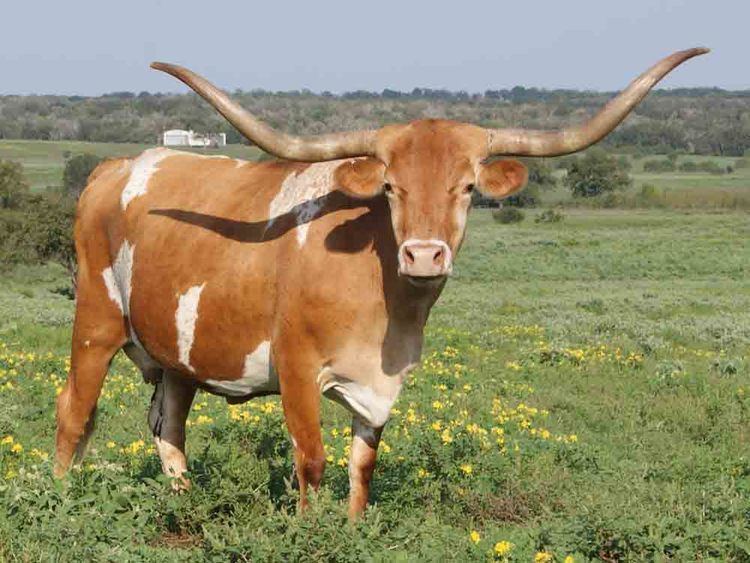 | ||
Similar Ankole‑Watusi, Hereford, Shorthorn, Brahman, English Longhorn | ||
Texas longhorn cattle tour at the vertically challenged cattle company 12 16 2012
The Texas Longhorn is a breed of cattle known for its characteristic horns, which can extend to over 1.8 m (5.9 ft) tip to tip for bulls, and 2.1 m (6.9 ft) tip to tip for steers and exceptional cows.
Contents
- Texas longhorn cattle tour at the vertically challenged cattle company 12 16 2012
- Texas longhorn cattle
- History of the breed
- Decline and revival
- Additional Reading
- References
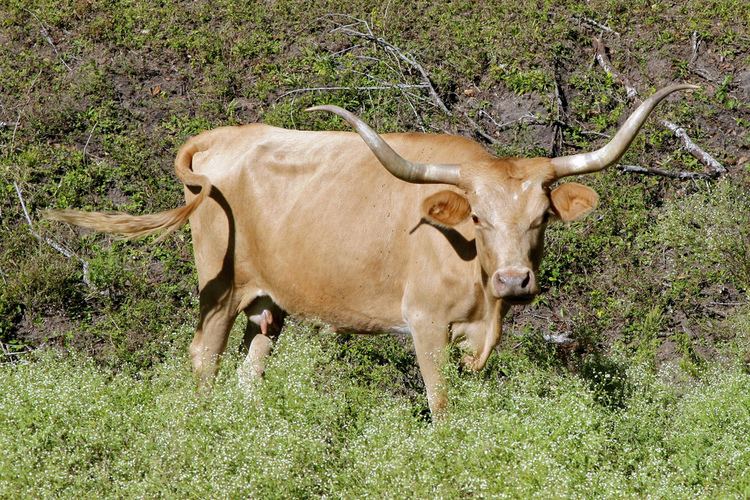
They are descendants of the first cattle in the New World, brought by Christopher Columbus and the Spanish colonists, and have a high drought-stress tolerance. Texas Longhorns are known for their diverse coloring, and can be any color or mix of colors, but dark red and white color mixes are the most dominant.
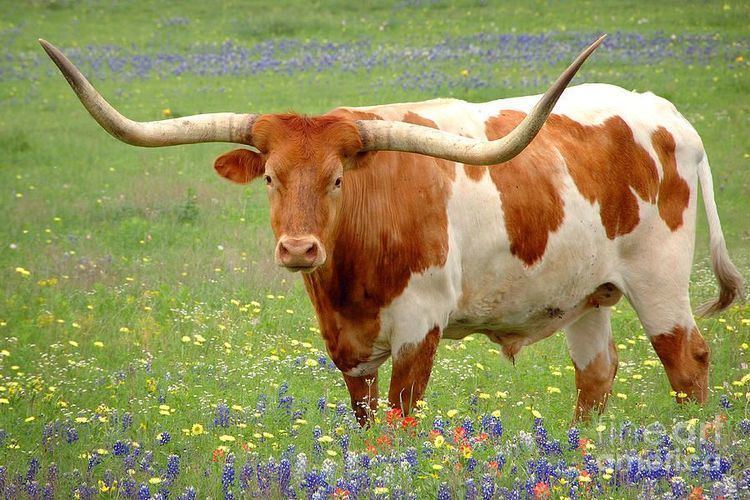
Registries for the breed include the Texas Longhorn Breeders Association of America, founded in 1913 by the Kerr County rancher Charles Schreiner, III; the International Texas Longhorn Association, and the Cattlemen's Texas Longhorn Registry.
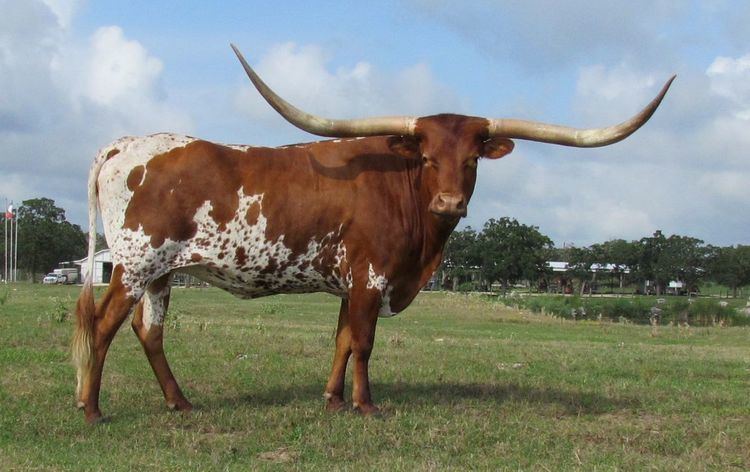
Texas longhorn cattle
History of the breed

Genetic analyses show the Longhorn originated from an Iberian hybrid of two ancient cattle lineages: "taurine" descending from the domestication of the wild aurochs in the Middle East, and "indicine", descending from the domestication of the aurochs in India, 85% and 15% respectively by proportion. The Texas Longhorns are direct descendants of the first cattle in the New World. The ancestral cattle were first brought over by Christopher Columbus in 1493 to the Caribbean island of Hispaniola. Between 1493 and 1512, Spanish colonists brought additional cattle in subsequent expeditions. The cattle consisted of three different breeds; Barrenda, Retinto and Grande Pieto. Over the next two centuries the Spanish moved the cattle north, arriving in the area that would become Texas near the end of the 17th century. The cattle escaped or were turned loose on the open range, where they remained mostly feral for the next two centuries. Over several generations, descendants of these cattle evolved the high feed- and drought-stress tolerance and other "hardy" characteristics that Longhorns have become known for.
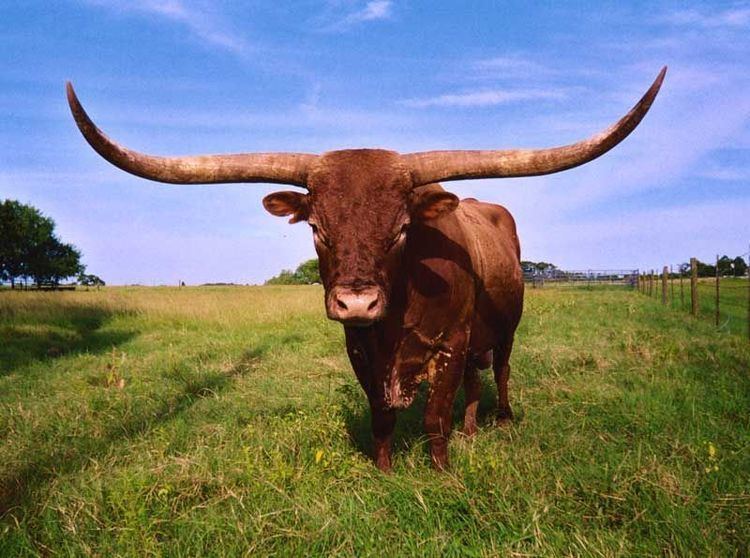
Early US settlers in Texas obtained feral Mexican cattle from the borderland between the Nueces River and the Rio Grande and mixed them with their own eastern cattle. The result was a tough, rangy animal with long legs and long horns extending up to seven feet. Although this interbreeding was of little consequence to the makeup of a Longhorn, it did alter color. The varieties of color ranged from bluish-grey, and various yellowish hues, to browns, black, ruddy and white, both cleanly bright and dirty-speckled. Portuguese cattle breeds, such as Alentejana and Mertolenga, are the closest relatives of Texas Longhorns.
Decline and revival
As Texas became more heavily settled following annexation by the US, the frontier gave way to established farms and ranch lands. The leaner longhorn beef was not as attractive in an era where tallow was highly prized, and the longhorn's ability to survive on the poor vegetation of the open range was no longer as much of an issue. Other breeds demonstrated traits more highly valued by the modern rancher, such as the ability to gain weight quickly. The Texas Longhorn stock slowly dwindled, until in 1927 the breed was saved from near extinction by enthusiasts from the United States Forest Service, who collected a small herd of stock to breed on the Wichita Mountains Wildlife Refuge in Lawton, Oklahoma. The breed also received significant attention after a longhorn named "Bevo" was adopted as the mascot of The University of Texas in 1917, and an image of the animal became commonly associated with Texas Longhorns sports teams.
A few years later, J. Frank Dobie and others gathered small herds to keep in Texas state parks. They were cared for largely as curiosities, but the stock's longevity, resistance to disease and ability to thrive on marginal pastures quickly revived the breed as beef stock and for their link to Texas history. Texas Longhorns with elite genetics can often fetch $40,000 or more at auction with the record of $380,000 on March 18, 2017 for a cow 3S Danica and heifer calf at side during the Legacy XIII sale in Fort Worth, Texas.
Commercial ranchers cross-breed longhorns with other breeds for increasing hybrid vigor and easy calving characteristics. Smaller birth weights reduce dystocia for first-calf heifers.
Due to their innate gentle disposition and intelligence, Texas Longhorns are also increasingly being trained as riding steers.
Additional Reading
Media related to Texas Longhorn cattle at Wikimedia Commons
